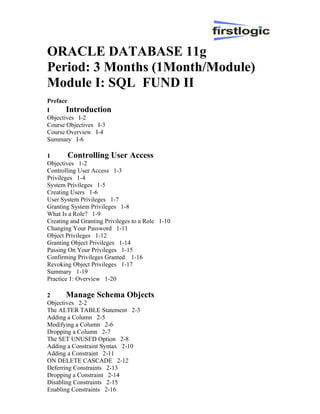
Oracle 11g
- 1. ORACLE DATABASE 11g Period: 3 Months (1Month/Module) Module I: SQL FUND II Preface I Introduction Objectives I-2 Course Objectives I-3 Course Overview I-4 Summary I-6 1 Controlling User Access Objectives 1-2 Controlling User Access 1-3 Privileges 1-4 System Privileges 1-5 Creating Users 1-6 User System Privileges 1-7 Granting System Privileges 1-8 What Is a Role? 1-9 Creating and Granting Privileges to a Role 1-10 Changing Your Password 1-11 Object Privileges 1-12 Granting Object Privileges 1-14 Passing On Your Privileges 1-15 Confirming Privileges Granted 1-16 Revoking Object Privileges 1-17 Summary 1-19 Practice 1: Overview 1-20 2 Manage Schema Objects Objectives 2-2 The ALTER TABLE Statement 2-3 Adding a Column 2-5 Modifying a Column 2-6 Dropping a Column 2-7 The SET UNUSED Option 2-8 Adding a Constraint Syntax 2-10 Adding a Constraint 2-11 ON DELETE CASCADE 2-12 Deferring Constraints 2-13 Dropping a Constraint 2-14 Disabling Constraints 2-15 Enabling Constraints 2-16
- 2. Cascading Constraints 2-18 Overview of Indexes 2-20 CREATE INDEX with CREATE TABLE Statement 2-21 Function-Based Indexes 2-23 Removing an Index 2-25 DROP TABLE ... PURGE 2-26 The FLASHBACK TABLE Statement 2-27 External Tables 2-29 Creating a Directory for the External Table 2-31 Creating an External Table 2-33 Creating an External Table Using ORACLE_LOADER 2-35 Querying External Tables 2-37 Summary 2-38 Practice 2: Overview 2-39 3 Manipulating Large Data Sets Objectives 3-2 Using Subqueries to Manipulate Data 3-3 Copying Rows from Another Table 3-4 Inserting Using a Subquery as a Target 3-5 Retrieving Data with a Subquery as Source 3-7 Updating Two Columns with a Subquery 3-8 Updating Rows Based on Another Table 3-9 Deleting Rows Based on Another Table 3-10 Using the WITH CHECK OPTION Keyword on DML Statements 3-11 Overview of the Explicit Default Feature 3-12 Using Explicit Default Values 3-13 Overview of Multitable INSERT Statements 3-14 Types of Multitable INSERT Statements 3-16 Multitable INSERT Statements 3-17 Unconditional INSERT ALL 3-19 Conditional INSERT ALL 3-20 Conditional INSERT FIRST 3-22 Pivoting INSERT 3-24 The MERGE Statement 3-27 The MERGE Statement Syntax 3-28 Merging Rows 3-29 Tracking Changes in Data 3-31 Example of the Flashback Version Query 3-32 The VERSIONS BETWEEN Clause 3-34 Summary 3-35 Practice 3: Overview 3-36 4 Generating Reports by Grouping Related Data Objectives 4-2
- 3. Review of Group Functions 4-3 Review of the GROUP BY Clause 4-4 Review of the HAVING Clause 4-5 GROUP BY with ROLLUP and CUBE Operators 4-6 ROLLUP Operator 4-7 ROLLUP Operator: Example CUBE Operator 4-9 CUBE Operator: Example 4-10 GROUPING Function 4-11 GROUPING Function: Example 4-12 GROUPING SETS 4-13 GROUPING SETS: Example 4-15 Composite Columns 4-17 Composite Columns: Example 4-19 Concatenated Groupings 4-21 Concatenated Groupings: Example 4-22 Summary 4-23 Practice 4: Overview 4-24 5 Managing Data in Different Time Zones Objectives 5-2 Time Zones 5-3 TIME_ZONE Session Parameter 5-4 CURRENT_DATE, CURRENT_TIMESTAMP, and LOCALTIMESTAMP 5-5 CURRENT_DATE 5-6 CURRENT_TIMESTAMP 5-7 LOCALTIMESTAMP 5-8 DBTIMEZONE and SESSIONTIMEZONE 5-9 TIMESTAMP Data Type 5-10 TIMESTAMP Data Types 5-11 TIMESTAMP Fields 5-12 Difference between DATE and TIMESTAMP 5-13 TIMESTAMP WITH TIMEZONE Data Type 5-14 TIMESTAMP WITH TIMEZONE: Example 5-15 TIMESTAMP WITH LOCAL TIMEZONE 5-16 TIMESTAMP WITH LOCAL TIMEZONE: Example 5-17 INTERVAL Data Types 5-18 INTERVAL Fields 5-20 INTERVAL YEAR TO MONTH Data Type 5-21 INTERVAL YEAR TO MONTH: Example 5-22 INTERVAL DAY TO SECOND Data Type 5-23 INTERVAL DAY TO SECOND Data Type: Example 5-24 EXTRACT 5-25 TZ_OFFSET 5-26 TIMESTAMP Conversion Using FROM_TZ 5-28 Converting to TIMESTAMP Using TO_TIMESTAMP and TO_TIMESTAMP_TZ 5-29 Time Interval Conversion with TO_YMINTERVAL 5-30 Using TO_DSINTERVAL: Example 5-31 Daylight Saving Time 5-32
- 4. Summary 5-34 Practice 5: Overview 5-35 6 Retrieving Data Using Subqueries Objectives 6-2 Multiple-Column Subqueries 6-3 Column Comparisons 6-4 Pairwise Comparison Subquery 6-5 Nonpairwise Comparison Subquery 6-6 Scalar Subquery Expressions 6-7 Scalar Subqueries: Examples 6-8 Correlated Subqueries 6-10 Using Correlated Subqueries 6-12 Using the EXISTS Operator 6-14 Find Employees Who Have at Least One Person Reporting to Them 6-15 Find All Departments That Do Not Have Any Employees 6-16 Correlated UPDATE 6-17 Using Correlated UPDATE 6-18 Correlated DELETE 6-20 Using Correlated DELETE 6-21 The WITH Clause 6-22 WITH Clause: Example 6-23 Summary 6-25 Practice 6: Overview 6-27 7 Hierarchical Retrieval Objectives 7-2 Sample Data from the EMPLOYEES Table 7-3 Natural Tree Structure 7-4 Hierarchical Queries 7-5 Walking the Tree 7-6 Walking the Tree: From the Bottom Up 7-8 Walking the Tree: From the Top Down 7-9 Ranking Rows with the LEVEL Pseudocolumn 7-10 Formatting Hierarchical Reports Using LEVEL and LPAD 7-11 Pruning Branches 7-13 Summary 7-14 Practice 7: Overview 7-15 8. Regular Expression Support Objectives 8-2 Regular Expression Overview 8-3 Meta Characters 8-4 Using Meta Characters 8-5 Regular Expression Functions 8-7
- 5. The REGEXP Function Syntax 8-8 Performing Basic Searches 8-9 Checking the Presence of a Pattern 8-10 Example of Extracting Substrings 8-11 Replacing Patterns 8-12 Regular Expressions and Check Constraints 8-13 Summary 8-14 Practice 8: Overview 8-15
- 6. ORACLE DATABASE 11g Module II: ADMINISTRATION I 1. Introduction 2. Installation 3. DB Creation 4. Instance 5. Storage 6. Users 7. Schema 8. Data & Concurrency 9. Undo 10. Security 11. Network 12. Proactive Maintenance 13. Performance 14. Backup & Recovery Concepts 15. Backup 16. Recovery
- 7. 17. Flashback 18. Moving Data ORACLE DATABASE 11g Module III: ADMINISTRATION II 1: Introduction 2: Configuring RMAN 3: Using RMAN 4: Non-Critical Recovery 5: Recovery 6: Flashback 7: Corruption 8: Memory 9: Performance 10: Schema 11: Storage 12: ASM 13: Resources 14: Scheduler
- 8. 15: Security 16: Globalization 17: Workshop